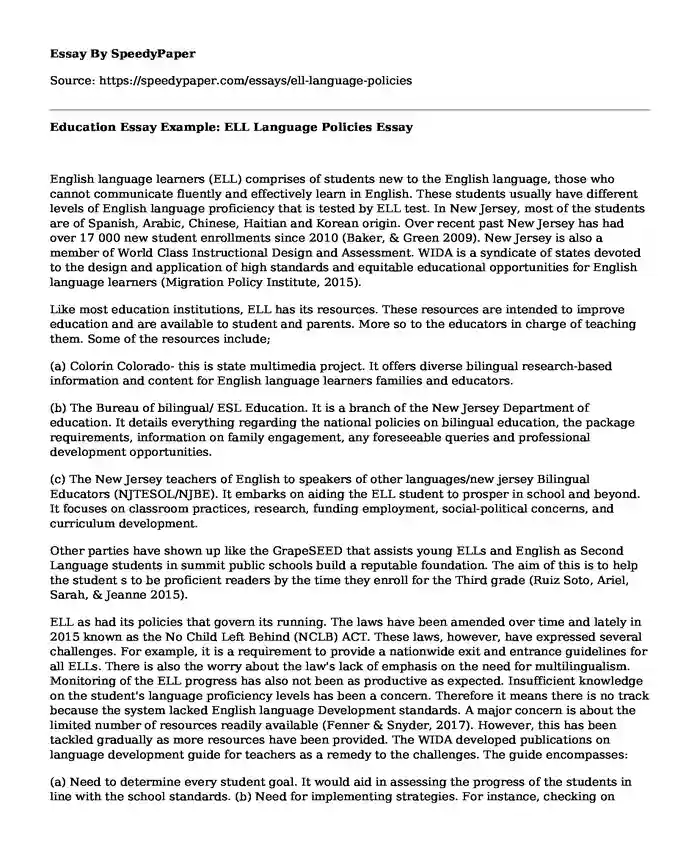English language learners (ELL) comprises of students new to the English language, those who cannot communicate fluently and effectively learn in English. These students usually have different levels of English language proficiency that is tested by ELL test. In New Jersey, most of the students are of Spanish, Arabic, Chinese, Haitian and Korean origin. Over recent past New Jersey has had over 17 000 new student enrollments since 2010 (Baker, & Green 2009). New Jersey is also a member of World Class Instructional Design and Assessment. WIDA is a syndicate of states devoted to the design and application of high standards and equitable educational opportunities for English language learners (Migration Policy Institute, 2015).
Like most education institutions, ELL has its resources. These resources are intended to improve education and are available to student and parents. More so to the educators in charge of teaching them. Some of the resources include;
(a) Colorin Colorado- this is state multimedia project. It offers diverse bilingual research-based information and content for English language learners families and educators.
(b) The Bureau of bilingual/ ESL Education. It is a branch of the New Jersey Department of education. It details everything regarding the national policies on bilingual education, the package requirements, information on family engagement, any foreseeable queries and professional development opportunities.
(c) The New Jersey teachers of English to speakers of other languages/new jersey Bilingual Educators (NJTESOL/NJBE). It embarks on aiding the ELL student to prosper in school and beyond. It focuses on classroom practices, research, funding employment, social-political concerns, and curriculum development.
Other parties have shown up like the GrapeSEED that assists young ELLs and English as Second Language students in summit public schools build a reputable foundation. The aim of this is to help the student s to be proficient readers by the time they enroll for the Third grade (Ruiz Soto, Ariel, Sarah, & Jeanne 2015).
ELL as had its policies that govern its running. The laws have been amended over time and lately in 2015 known as the No Child Left Behind (NCLB) ACT. These laws, however, have expressed several challenges. For example, it is a requirement to provide a nationwide exit and entrance guidelines for all ELLs. There is also the worry about the law's lack of emphasis on the need for multilingualism. Monitoring of the ELL progress has also not been as productive as expected. Insufficient knowledge on the student's language proficiency levels has been a concern. Therefore it means there is no track because the system lacked English language Development standards. A major concern is about the limited number of resources readily available (Fenner & Snyder, 2017). However, this has been tackled gradually as more resources have been provided. The WIDA developed publications on language development guide for teachers as a remedy to the challenges. The guide encompasses:
(a) Need to determine every student goal. It would aid in assessing the progress of the students in line with the school standards. (b) Need for implementing strategies. For instance, checking on other online resources to determine and understand the meaning of vocabularies and sentence structure. (c) Teachers are required to provide evidence and be accountable. This is to ascertain that the students have learned and met the objectives of the ELL syllabus. (d) Teachers should also share and discuss. It aims at agreeing on the best possible way to model and instruct especially the research materials. (e) Reflection on the assessment. In this case, teachers are advised to check if the student's goals are in line with the achievements made. Teachers also need to provide evidence supporting their claims and the ability of the students to deliver what they have learned (Gottlieb, 2013).
In conclusion, there has been a notable change in the efficiency under which ELLs are being delivered. Improvement has impacted especially with research and tools guiding the educators. I also believe there will be continued achievements in the learning of ELL.
References
Baker, B. D., & Green III, P. C. (2009). Equal educational opportunity and the distribution of state aid to schools: Can or should school racial composition be a factor?. Journal of Education Finance, 289-323.
Fenner, D. S., & Snyder, S. (2017). Unlocking English Learners' Potential: Strategies for Making Content Accessible. Corwin Press.
Gottlieb, M. (2013). Essential Actions: A Handbook for Implementing WIDA's Framework for English Language Development Standards. WiDA Consortium.
Ruiz Soto, A. G., Hooker, S., & Batalova, J. (2015). States and districts with the highest number and share of English language learners. Washington, DC: Migration Policy Institute.
Zong, J., & Batalova, J. (2015). Frequently requested statistics on immigrants and immigration in the United States. Migration Policy Institute, 26, 1-18.
Cite this page
Education Essay Example: ELL Language Policies. (2022, Sep 05). Retrieved from https://speedypaper.net/essays/ell-language-policies
Request Removal
If you are the original author of this essay and no longer wish to have it published on the SpeedyPaper website, please click below to request its removal:
- Literature Review Essay Sample on BOMB: The Race to Build and Steal
- Romeo and Juliet - Comparison Essay on the 1968 Zeffirelli Movie and the Play
- Essay Example with Annotated Bibliography on Cultural Globalization
- Essay Example: Gender Difference in Treatment of Major Depression Disorder
- Essay Sample on Post-Hip Fracture Rehabilitation for Patients at Home
- Free Essay Example - New Software for the Insurance Agency
- Free Essay Sample: Summary of Dissertation
Popular categories





